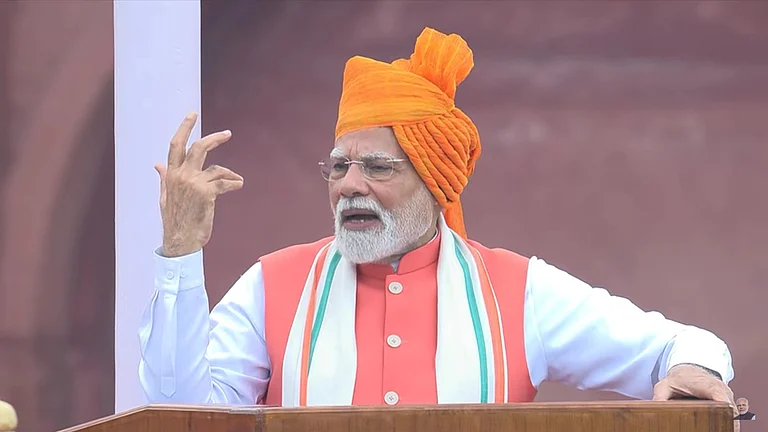The Group of Ministers (GoM) on GST rate rationalisation will meet this week.
The panel is expected review reforms announced by PM Modi in his Independence Day speech.
The GoM, led by Bihar Deputy CM Samrat Choudhary, includes ministers from Kerala, Uttar Pradesh, Rajasthan, West Bengal, and Karnataka.
Finance ministry officials earlier briefed members on the proposal, which suggests a simplified two-slab GST structure.
GoM to Review PM Modi’s GST Reform Proposal This Week
Following PM Modi’s speech from the Red Fort, the finance ministry said, “To build an ‘Atmanirbhar Bharat’, the Central Government is proposing significant reforms in GST.” The proposal has been sent to the GoM constituted by the GST Council to examine the issue
The Group of Ministers (GoM) on GST rate rationalisation is scheduled to meet this week to deliberate on a new set of reforms outlined by Prime Minister Narendra Modi in his Independence Day address. The panel, comprising ministers from six states, is led by Bihar Deputy Chief Minister Samrat Choudhary and includes representatives from Kerala, Uttar Pradesh, Rajasthan, West Bengal, and Karnataka.
According to reports citing finance ministry officials, a briefing on the proposal was shared with panel members a day before the PM’s speech by the Department of Revenue. The department will also present the proposal to the GoM during the meeting. Reports further suggest that the proposed two-rate structure of 5% and 18% would generate revenue comparable to the current system.
At present, GST is divided into four slabs, 5%, 12%, 18%, and 28%, in addition to a compensation cess ranging from 1% to 290% on items such as luxury cars, air conditioners, pan masala, tobacco, and cigarettes.
The new plan envisions placing most goods and services in either the 5% or 18% bracket. Daily-use items, farm inputs, and essentials for MSMEs would fall under the lower rate, thereby easing the tax burden and encouraging consumption, while most other products and services would be taxed at 18%. For sin and demerit goods, the government is considering a special rate of 40% in line with social and health concerns.
Following PM Modi’s speech from the Red Fort, the finance ministry said, “To build an ‘Atmanirbhar Bharat’, the Central Government is proposing significant reforms in GST. It will be focused on three pillars, namely, structural reforms, rate rationalisation, and ease of living.” The proposal has been sent to the GoM constituted by the GST Council to examine the issue.
The ministry added, “Key areas identified for next-generation reforms include the rationalisation of tax rates to benefit all sections of society, especially the common man, women, students, the middle class, and farmers. Reforms will also seek to reduce classification-related disputes, correct inverted duty structures in specific sectors, ensure greater rate stability, and further enhance ease of doing business.”
Explaining the proposal further, the ministry said that under structural reforms it aims to correct inverted duty structures, resolve classification disputes, and provide greater policy stability. “The correction of inverted duty structures will reduce the accumulation of input tax credit and support domestic value addition,” it stated.
The ministry also said the plan is to reduce slabs and “essentially move towards a simple tax with two slabs—standard and merit, with special rates only for a few items.” It added that reducing taxes on essential and aspirational goods would make them more affordable and help drive consumption. It also noted that “the end of compensation cess has created fiscal space” to realign rates for long-term sustainability.
Additionally, the proposal states that registration would become “seamless, technology-driven, and time-bound,” while tax returns would feature pre-filled forms to reduce errors and disputes. Refunds, particularly for exporters and businesses facing inverted duty structures, would be processed faster through automated systems.
Tight Timeline
According to the Indian Express, the Centre is working on a tight timeline, with at least three GoM meetings expected before a final proposal is placed before the GST Council, the top decision-making body on indirect taxes. The government is reportedly aiming for a rollout ahead of Diwali to give businesses time to adjust without disrupting festive demand.
The GoM was first constituted in September 2021 under then Karnataka Chief Minister Basavaraj Bommai, who submitted an interim report in June 2022 recommending selective changes.
Following political changes in Bihar and Karnataka, the panel was reconstituted in October 2024. It is currently chaired by Bihar Deputy Chief Minister Samrat Choudhary. Other members include Uttar Pradesh Finance Minister Suresh Kumar Khanna, Rajasthan Health Services Minister Gajendra Singh, Karnataka Revenue Minister Krishna Byre Gowda, West Bengal Finance Minister Chandrima Bhattacharya, and Kerala Finance Minister K.N. Balagopal.
